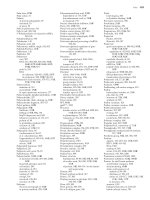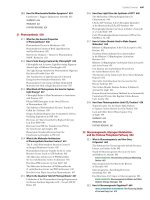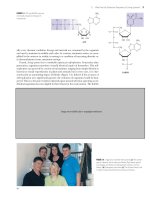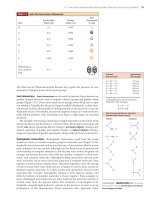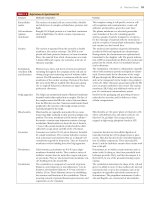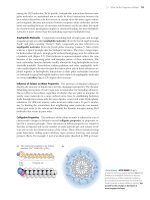Biochemistry, 4th Edition P34 docx
Bạn đang xem bản rút gọn của tài liệu. Xem và tải ngay bản đầy đủ của tài liệu tại đây (459.63 KB, 10 trang )
10.1 What Are the Structure and Chemistry of Nitrogenous Bases? 293
The Properties of Pyrimidines and Purines Can Be Traced to Their
Electron-Rich Nature
The aromaticity of the pyrimidine and purine ring systems and the electron-rich
nature of their carbonyl and ring nitrogen substituents endow them with the ca-
pacity to undergo keto–enol tautomeric shifts. That is, pyrimidines and purines ex-
ist as tautomeric pairs, as shown in Figure 10.6 for uracil and Figure 10.7 for gua-
nine. The keto tautomers of uracil, thymine, and guanine vastly predominate at
neutral pH. In other words, pK
a
values for ring nitrogen atoms 1 and 3 in uracil
(Figure 10.6) are greater than 8 (the pK
a
value for N-3 is 9.5). In contrast, the enol
form of cytosine predominates at pH 7 and the pK
a
value for N-3 in this pyrimidine
is 4.5. Similarly, for guanine (Figure 10.7), the pK
a
value is 9.4 for N-1 and less than
5 for N-3. These pK
a
values specify whether protons are associated with the various
ring nitrogens at neutral pH. As such, they are important in determining whether
these nitrogens serve as H-bond donors or acceptors. Hydrogen bonding between
purine and pyrimidine bases is fundamental to the biological functions of nucleic
acids, as in the formation of the double-helix structure of DNA (see Section 10.5).
The important functional groups participating in H-bond formation are the amino
groups of cytosine, adenine, and guanine; the ring nitrogens at position 3 of pyrim-
idines and position 1 of purines; and the strongly electronegative oxygen atoms at-
tached at position 4 of uracil and thymine, position 2 of cytosine, and position 6 of
guanine (see Figure 10.17).
Another property of pyrimidines and purines is their strong absorbance of ul-
traviolet (UV) light, which is also a consequence of the aromaticity of their hete-
rocyclic ring structures. Figure 10.8 shows characteristic absorption spectra of
Adenine
(6-amino purine)
N
N
NH
2
Guanine
(2-amino-6-oxy purine)
N
N
H
N
H
2
N
N
N
H
N
H
O
FIGURE 10.4 The common purine bases—adenine and guanine—in the tautomeric forms predominant at pH 7.
Hypoxanthine
N
N
N
H
N
H
O
Xanthine
N
N
N
H
N
H
H
O
O
Uric acid
N
N
N
H
N
H
H
O
H
O
O
FIGURE 10.5 Other naturally occurring purine
derivatives—hypoxanthine, xanthine, and uric acid.
O
Keto
N
N
H
Enol
N
N
OH
H
2
N
N
N
H
N
N
H
H
2
N
FIGURE 10.7 The tautomerization of the purine guanine.
O
Keto
N
N
H
H
O
Enol
N
N
HO
OH
FIGURE 10.6 The keto–enol tautomerization of uracil.
294 Chapter 10 Nucleotides and Nucleic Acids
several of the common bases of nucleic acids—adenine, uracil, cytosine, and
guanine—in their nucleotide forms: AMP, UMP, CMP, and GMP (see Section 10.3).
This property is particularly useful in quantitative and qualitative analysis of nu-
cleotides and nucleic acids.
10.2 What Are Nucleosides?
Nucleosides are compounds formed when a base is linked to a sugar. The sugars of nu-
cleosides are pentoses (five-carbon sugars, see Chapter 7). Ribonucleosides contain
the pentose
D-ribose, whereas 2-deoxy-D-ribose is found in deoxyribonucleosides.
In both instances, the pentose is in the five-membered ring form furanose:
D
-ribofuranose for ribonucleosides and 2-deoxy-D-ribofuranose for deoxyribonucleo-
sides (Figure 10.9). In nucleosides, these ribofuranose atoms are numbered as 1Ј, 2Ј,
3Ј, and so on to distinguish them from the ring atoms of the nitrogenous bases. The
base is linked to the sugar via a glycosidic bond. Glycosidic bonds in nucleosides (and
nucleotides, see following discussion) are always of the -configuration. Nucleosides
are named by adding the ending -idine to the root name of a pyrimidine or -osine to the
root name of a purine. The common nucleosides are thus cytidine, uridine, thymidine,
220
Absorbance
0
0.2
0.4
0.6
0.8
1.0
240 260 280 300 220 240 260 280 300 220 240 260 280 300 220 240 260 280 300
pH 7
pH 2
5'-AMP
5'-UMP 5'-CMP
5'-GMP
Wavelength, nm
pH 7
pH 11
pH 7
pH 2
pH 7
pH 1
Absorbance
0
0.2
0.4
0.6
0.8
1.0
Absorbance
0
0.2
0.4
0.6
0.8
1.0
Absorbance
0
0.2
0.4
0.6
0.8
1.0
Wavelength, nm Wavelength, nm Wavelength, nm
FIGURE 10.8 The UV absorption spectra of the common
ribonucleotides.
HUMAN BIOCHEMISTRY
Adenosine: A Nucleoside with Physiological Activity
For the most part, nucleosides have no biological role other than
to serve as component parts of nucleotides. Adenosine is a rare
exception. In mammals, adenosine functions as an autacoid, or
“local hormone,” and as a neuromodulator. This nucleoside cir-
culates in the bloodstream, acting locally on specific cells to
influence such diverse physiological phenomena as blood vessel
dilation, smooth muscle contraction, neuronal discharge, neuro-
transmitter release, and metabolism of fat. For example, when
muscles work hard, they release adenosine, causing the sur-
rounding blood vessels to dilate, which in turn increases the flow
of blood and its delivery of O
2
and nutrients to the muscles. In a
different autacoid role, adenosine acts in regulating heartbeat.
The natural rhythm of the heart is controlled by a pacemaker, the
sinoatrial node, which cyclically sends a wave of electrical excita-
tion to the heart muscles. By blocking the flow of electrical cur-
rent, adenosine slows the heart rate. Supraventricular tachycardia is
a heart condition characterized by a rapid heartbeat. Intravenous
injection of adenosine causes a momentary interruption of the
rapid cycle of contraction and restores a normal heart rate.
Adenosine is licensed and marketed as Adenocard to treat
supraventricular tachycardia.
In addition, adenosine is implicated in sleep regulation. Dur-
ing periods of extended wakefulness, extracellular adenosine lev-
els rise as a result of metabolic activity in the brain, and this in-
crease promotes sleepiness. During sleep, adenosine levels fall.
Caffeine promotes wakefulness by blocking the interaction of ex-
tracellular adenosine with its neuronal receptors.*
*Porrka-Heiskanen, T., et al., 1997. Adenosine: A mediator of the sleep-
inducing effects of prolonged wakefulness. Science 276:1265–1268; and
Vaugeois, J-M., 2002. Signal transduction: Positive feedback from coffee.
Nature 418:734–736.
H
3
C
H
3
C
H
3
C
O
N
N
N
Caffeine
O
N
ᮡ
Caffeine is an alkaloid, a term used to define naturally occurring
nitrogenous molecules that have pharmacological effects. Alkaloids are
classified according to their metabolic precursors, so caffeine is a
purine alkaloid.
10.3 What Are the Structure and Chemistry of Nucleotides? 295
HO
C
COHH
COHH
H
2
COH
D-Ribose
1
3
4
5
O
HOCH
2
OH
HH
HH
OH OH
-
D-Ribofuranose
Furanose form of
D-Ribose
HO
C
H
2
COH
D-2-Deoxyribose
1
2
5
O
HOCH
2
OH
HH
HH
-
D-2-Deoxyribofuranose
Furanose form of
D-2-Deoxyribose
OH H
5
41
32
COHH
COHH
COHH
CHH
3
4
2
14
5
23
FIGURE 10.9 Furanose structures—ribose and
deoxyribose.
NH
2
N
N
O
HOCH
2
HH
HH
OH OH
Cytidine
O
N
N
O
HOCH
2
HH
HH
OH OH
Uridine
O
H
NH
2
N
N
O
HOCH
2
HH
HH
OH OH
Adenosine
N
N
N
N
O
HOCH
2
HH
HH
OH OH
Guanosine
N
N
H
NH
2
N
N
O
HOCH
2
H
HH
OH OH
Inosine, a less common nucleoside
N
N
O
O
O
H
Hypoxanthine
FIGURE 10.10 The common ribonucleosides—cytidine,
uridine, adenosine, and guanosine—and the less-
common inosine. (Purine nucleosides and nucleotides
usually adopt the anti conformation, where the purine
ring is not above the ribose, as it would be in the syn
conformation. Pyrimidines are always anti, never syn,
because the 2-O atom of pyrimidines sterically hinders
the ring from a position above the ribose.)
adenosine, and guanosine (Figure 10.10). Nucleosides are more water soluble than the
free bases, because of the hydrophilicity of the pentose.
10.3 What Are the Structure and Chemistry of Nucleotides?
A nucleotide results when phosphoric acid is esterified to a sugar OOH group of
a nucleoside. The nucleoside ribose ring has three OOH groups available for
esterification, at C-2Ј, C-3Ј, and C-5Ј (although 2Ј-deoxyribose has only two). The
vast majority of monomeric nucleotides in the cell are ribonucleotides having
5Ј-phosphate groups. Figure 10.11 shows the structures of the common four ribo-
nucleotides, whose formal names are adenosine 5-monophosphate, guanosine
5-monophosphate, cytidine 5-monophosphate, and uridine 5-monophosphate.
These compounds are more often referred to by their abbreviations: 5-AMP,
5-GMP, 5-CMP, and 5-UMP, or even more simply as AMP, GMP, CMP,
and UMP. Because the pK
a
value for the first dissociation of a proton from the
phosphoric acid moiety is 1.0 or less, the nucleotides have acidic properties. This
acidity is implicit in the other names by which these substances are known—
adenylic acid, guanylic acid, cytidylic acid, and uridylic acid. The pK
a
value for
the second dissociation, pK
2
, is about 6.0, so at neutral pH or above, the net
charge on a nucleoside monophosphate is Ϫ2. Nucleic acids, which are polymers
of nucleoside monophosphates, derive their name from the acidity of these phos-
phate groups.
296 Chapter 10 Nucleotides and Nucleic Acids
Cyclic Nucleotides Are Cyclic Phosphodiesters
Nucleoside monophosphates in which the phosphoric acid is esterified to two of the
available ribose hydroxyl groups (Figure 10.12) are found in all cells. Forming two
such ester linkages with one phosphate results in a cyclic phosphodiester structure.
3,5-cyclic AMP, often abbreviated cAMP, and its guanine analog 3,5-cyclic GMP,
or cGMP, are important regulators of cellular metabolism (see Parts 3 and 4).
Nucleoside Diphosphates and Triphosphates Are Nucleotides
with Two or Three Phosphate Groups
Additional phosphate groups can be linked to the phosphoryl group of a
nucleotide through the formation of phosphoric anhydride linkages, as shown
in Figure 10.13. Addition of a second phosphate to AMP creates adenosine
5-diphosphate, or ADP, and adding a third yields adenosine 5-triphosphate, or
ATP. The respective phosphate groups are designated by the Greek letters ␣,
, and ␥, starting with the ␣-phosphate as the one linked directly to the pentose.
The abbreviations GTP, CTP, and UTP represent the other corresponding nucle-
oside 5Ј-triphosphates. Like the nucleoside 5Ј-monophosphates, the nucleoside
5Ј-diphosphates and 5Ј-triphosphates all occur in the free state in the cell, as do
their deoxyribonucleoside phosphate counterparts, represented as dAMP, dADP,
and dATP; dGMP, dGDP, and dGTP; dCMP, dCDP, and dCTP; dUMP, dUDP, and
dUTP; and dTMP, dTDP, and dTTP.
NDPs and NTPs Are Polyprotic Acids
Nucleoside 5-diphosphates (NDPs) and nucleoside 5-triphosphates (NTPs) are
relatively strong polyprotic acids in that they dissociate three and four protons, re-
spectively, from their phosphoric acid groups. The resulting phosphate anions on
NDPs and NTPs form stable complexes with divalent cations such as Mg
2ϩ
and Ca
2ϩ
.
Because Mg
2ϩ
is present at high concentrations (as much as 40 mM) intracellularly,
NDPs and NTPs occur primarily as Mg
2ϩ
complexes in the cell.
A phosphoester bond
P
–
O
NH
2
N
N
O
OCH
2
HH
HH
OH OH
Adenosine 5'-monophosphate
(or AMP or adenylic acid)
N
N
–
OP
–
O
O
N
N
O
OCH
2
HH
HH
OH OH
Guanosine 5'-monophosphate
(or GMP or guanylic acid)
N
N
–
O
H
NH
2
P
–
O
N
N
O
OCH
2
HH
HH
OH OH
Uridine 5'-monophosphate
(or UMP or uridylic acid)
–
OP
–
O
N
N
O
HH
HH
OH OH
Cytidine 5'-monophosphate
(or CMP or cytidylic acid)
–
O
H
O
5'
5'
5'
5'
OCH
2
NH
2
O
P
–
O
–
O
NH
2
N
N
O
HOCH
2
HH
HH
OOH
A nucleoside 3'-monophosphate
3'-AMP
N
N
O
3'
O
O
O
O
O
FIGURE 10.11 Structures of the four common ribonucleotides—AMP, GMP, CMP, and UMP. Also shown is the
nucleotide 3Ј-AMP.
N
N
O
C
H
H
HH
O
OH
3',5'-Cyclic AMP
N
N
5'
NH
2
3'
O
P
O
N
N
O
H
HH
OH
3',5'-Cyclic GMP
N
N
3'
O
H
NH
2
O
–
O
H
P
H
H
C
O
5'
H
H
O
–
O
FIGURE 10.12 The cyclic nucleotides cAMP and cGMP.
10.4 What Are Nucleic Acids? 297
Nucleoside 5-Triphosphates Are Carriers of Chemical Energy
Nucleoside 5Ј-triphosphates are indispensable agents in metabolism because the
phosphoric anhydride bonds they possess are a prime source of chemical energy to
do biological work.
Virtually all of the biochemical reactions of nucleotides involve either phosphate
or pyrophosphate group transfer: the release of a phosphoryl group from an NTP to
give an NDP, the release of a pyrophosphoryl group to give an NMP unit, or the ac-
ceptance of a phosphoryl group by an NMP or an NDP to give an NDP or an NTP
(Figure 10.14). The pentose and the base are not directly involved in this chemistry.
A “division of labor” directs ATP to serve as the primary nucleotide in central path-
ways of energy metabolism, whereas GTP is used to drive protein synthesis. Thus,
the various nucleotides are channeled in appropriate metabolic directions through
specific recognition of the base of the nucleotide. The bases of nucleotides never
participate directly in the covalent bond chemistry that goes on.
10.4 What Are Nucleic Acids?
Nucleic acids are polynucleotides: linear polymers of nucleotides linked 3Ј to 5Ј by
phosphodiester bridges (Figure 10.15). They are formed as 5Ј-nucleoside mono-
phosphates are successively added to the 3Ј-OH group of the preceding nucleotide,
a process that gives the polymer a directional sense. Polymers of ribonucleotides are
named ribonucleic acid, or RNA. Deoxyribonucleotide polymers are called deoxy-
ribonucleic acid, or DNA. Because C-1Ј and C-4Ј in deoxyribonucleotides are in-
volved in furanose ring formation and because there is no 2Ј-OH, only the 3Ј- and
5Ј-hydroxyl groups are available for internucleotide phosphodiester bonds. In the
case of DNA, a polynucleotide chain may contain hundreds of millions of nu-
cleotide units. The convention in all notations of nucleic acid structure is to read the polynu-
cleotide chain from the 5Ј-end of the polymer to the 3Ј-end. Note that this reading direction
actually passes through each phosphodiester from 3Ј to 5Ј (Figure 10.15). A repeti-
tious uniformity exists in the covalent backbone of polynucleotides.
–
O
NH
2
N
N
O
OCH
2
HH
HH
OH OH
AMP (adenosine 5'-monophosphate)
N
N
HO
5'
A phosphoric
anhydride
–
O
–
OOH
H
2
O
+
Phosphate (P
i
) +
–
O
NH
2
N
N
O
OCH
2
H
HH
OH OH
ADP (adenosine 5'-diphosphate)
N
N
5'
–
O
–
O
Water
+
O+
–
O
NH
2
N
N
O
OCH
2
HH
HH
OH OH
ADP
N
N
5'
–
O
–
O
Phosphate
+
–
O
HOOH
+ O
–
O
NH
2
N
N
O
OCH
2
HH
HH
OH OH
ATP (adenosine 5'-triphosphate)
N
N
5'
–
O
OO
+
–
O
–
O
␥␣
OO OO
O
OO
OOO
α ␣
PP
PP
PP
PPP
P
H
2
O
FIGURE 10.13 Formation of ADP and ATP by the successive addition of phosphate groups via phosphoric
anhydride linkages. Note that the reaction is a dehydration synthesis reaction.
298 Chapter 10 Nucleotides and Nucleic Acids
Uracil
P
–
O
O
NH
2
N
N
O
OCH
2
O
OH
N
N
5'
O
etc.
3'
P
–
O
NH
2
N
N
O
OCH
2
O
OH
5'
O
3'
O
P
–
O
NH
2
N
N
O
OCH
2
O
OH
N
N
5'
O
3'
P
–
O
N
N
O
OCH
2
O
OH
5'
O
3'
O
H
H
etc.
Adenine
Cytosine
Guanine
Ribonucleic acid
(RNA)
Adenine
P
–
O
O
N
N
O
OCH
2
O
5'
O
etc.
3'
P
–
O
O
OCH
2
O
5'
O
3'
P
–
O
O
OCH
2
O
5'
O
3'
P
–
O
O
OCH
2
O
5'
O
3'
etc.
Thymine
Guanine
Cytosine
Deoxyribonucleic acid
(DNA)
H
O
H
3
C
NH
2
N
N
N
N
H
NH
2
N
N
O
N
N
N
NH
2
O
O
O
O
N
FIGURE 10.15 3Ј,5Ј-phosphodiester bridges link nucleo-
tides together to form polynucleotide chains.The
5Ј-ends of the chains are at the top; the 3Ј-ends are at
the bottom.
PHOSPHORYL GROUP TRANSFER:
OCH
2
O
O
P
O
–
–
OOPP
O
O
–
O
O
–
O
Base
OHHO
NTP
+ ROH OCH
2
–
OOPP
O
O
–
O
O
–
O
Base
OHHO
+ RO
O
P
O
–
O
–
NDP
PYROPHOSPHORYL GROUP TRANSFER:
OCH
2
O
O
P
O
–
–
OOPP
O
O
–
O
O
–
O
Base
OHHO
NTP
+ ROH OCH
2
O
–
OPP
O
O
–
O
O
–
O
Base
OHHO
+ RO
O
P
O
–
O
–
NMP
NUCLEOTIDYL GROUP TRANSFER:
OCH
2
O
O
P
O
–
–
OOPP
O
O
–
O
O
–
O
Base
OHHO
NTP
+ ROH HO P
O
O
–
+ O
O
P
O
–
O
–
OCH
2
P
O
O
–
O
Base
OHHO
OR
R–NMP
FIGURE 10.14 Phosphoryl, pyrophos-
phoryl, and nucleotidyl group transfer,
the major biochemical reactions of
nucleotides.
10.5 What Are the Different Classes of Nucleic Acids? 299
The Base Sequence of a Nucleic Acid Is Its Distinctive Characteristic
The only significant variation that commonly occurs in the chemical structure of nu-
cleic acids is the nature of the base at each nucleotide position. These bases are not
part of the sugar–phosphate backbone but instead serve as distinctive side chains,
much like the R groups of amino acids along a polypeptide backbone. They give the
polymer its unique identity. A simple notation for nucleic acid structures is merely to
list the order of bases in the polynucleotide using single capital letters—A, G, C, and
U (or T). Occasionally, a lowercase “p” is written between each successive base to indi-
cate the phosphodiester bridge, as in GpApCpGpUpA.
To distinguish between RNA and DNA sequences, DNA sequences may be pre-
ceded by a lowercase “d” to denote deoxy, as in d-GACGTA. From a simple string of
letters such as this, any biochemistry student should be able to draw the unique
chemical structure of, for example, a pentanucleotide, even though it may contain
more than 200 atoms.
10.5 What Are the Different Classes of Nucleic Acids?
The two major classes of nucleic acids are DNA and RNA. DNA has only one bio-
logical role, but it is the more central one. The information to make all the func-
tional macromolecules of the cell (even DNA itself) is preserved in DNA and ac-
cessed through transcription of the information into RNA copies. Coincident with
DNA’s singular purpose, simple life forms such as viruses or bacteria usually contain
only a single DNA molecule (or “chromosome”). Such DNA molecules must be
quite large in order to embrace enough information for making the macromole-
cules necessary to maintain a living cell. The Escherichia coli chromosome has a mo-
lecular mass of 2.9 ϫ 10
9
D and contains more than 9 million nucleotides. Eukary-
otic cells have many chromosomes, and DNA is found principally in two copies in
the diploid chromosomes of the nucleus. DNA is also found in mitochondria and
in chloroplasts, where it encodes some of the proteins and RNAs unique to these
organelles.
In contrast, RNA occurs in multiple copies and various forms. Cells typically con-
tain about eight times as much RNA as DNA. RNA has a number of important bio-
logical functions, its central one being information transfer from DNA to protein.
RNA molecules playing this role are categorized into several major types: messen-
ger RNA, ribosomal RNA, transfer RNA, and small nuclear RNA. Another type,
small RNAs (RNA 21 to 28 nucleotides in length), consists of important players in
gene regulation. Beyond various roles in information transfer, RNA participates in
a number of metabolic functions, including the processing and modification of
tRNA, rRNA, and mRNA and several maintenance or “housekeeping” functions,
such as preservation of telomeres.
With these basic definitions in mind, let’s now briefly consider the chemical and
structural nature of DNA and the various RNAs. Chapter 11 elaborates on methods
to determine the primary structure of nucleic acids by sequencing methods and dis-
cusses the secondary and tertiary structures of DNA and RNA. Part IV, Information
Transfer, includes a detailed treatment of the dynamic role of nucleic acids in the
molecular biology of the cell.
The Fundamental Structure of DNA Is a Double Helix
The DNA isolated from different cells and viruses characteristically consists of two
polynucleotide strands wound together to form a long, slender, helical molecule,
the DNA double helix. The strands run in opposite directions; that is, they are
antiparallel. The two strands are held together in the double helical structure
through interchain hydrogen bonds (Figure 10.16). These H bonds pair the bases of
nucleotides in one chain to complementary bases in the other, a phenomenon
called base pairing.
Telomeres are specialized sequences at the ends
of chromosomes.
300 Chapter 10 Nucleotides and Nucleic Acids
Erwin Chargaff’s Analysis of the Base Composition of Different DNAs Provided a
Key Clue to DNA Structure A clue to the chemical basis of base pairing in DNA came
from the analysis of the base composition of various DNAs by Erwin Chargaff in the
late 1940s. His data showed that the four bases commonly found in DNA (A, C, G, and
T) do not occur in equimolar amounts and that the relative amounts of each vary from
species to species (Table 10.1). Nevertheless, Chargaff noted that certain pairs of bases,
namely, adenine and thymine, and guanine and cytosine, are always found in a 1Ϻ1 ra-
tio and that the number of pyrimidine residues always equals the number of purine
residues. These findings are known as Chargaff’s rules: [A] ؍ [T]; [C] ؍ [G]; [pyrim-
idines] ؍ [purines].
5'3'
5' 3'
5' end 3' end
5'
5'
5'
5'
5'
3'
3'
3'
3'
3'
5'
5'
5'
5'
5'
3'
3'
3'
3'
3'
3' end 5' end
TA
GC
AT
CG
TA
3'
5'
Segment of unwound double helix
illustrating the antiparallel orientation
of the complementary strands
5'
3'
P
P
P
P
P
P
P
P
P
P
P
P
FIGURE 10.16 The antiparallel nature of the DNA double
helix.
Adenine Thymine Adenine Guanine Purines
to to to to to
Source Guanine Cytosine Thymine Cytosine Pyrimidines
Ox 1.29 1.43 1.04 1.00 1.1
Human 1.56 1.75 1.00 1.00 1.0
Hen 1.45 1.29 1.06 0.91 0.99
Salmon 1.43 1.43 1.02 1.02 1.02
Wheat 1.22 1.18 1.00 0.97 0.99
Yeast 1.67 1.92 1.03 1.20 1.0
Haemophilus influenzae 1.74 1.54 1.07 0.91 1.0
E. coli K-12 1.05 0.95 1.09 0.99 1.0
Avian tubercle bacillus 0.4 0.4 1.09 1.08 1.1
Serratia marcescens 0.7 0.7 0.95 0.86 0.9
Bacillus schatz 0.7 0.6 1.12 0.89 1.0
Source: After Chargaff,E., 1951. Structure and function of nucleic acids as cell constituents. Federation Proceedings
10:654–659.
TABLE 10.1
Molar Ratios Leading to the Formulation of Chargaff’s Rules
10.5 What Are the Different Classes of Nucleic Acids? 301
Watson and Crick’s Postulate of the DNA Double Helix Became the Icon of DNA
Structure
James Watson and Francis Crick, working in the Cavendish Laboratory
at Cambridge University in 1953, took advantage of Chargaff’s results and the data
obtained by Rosalind Franklin and Maurice Wilkins in X-ray diffraction studies on
the structure of DNA to conclude that DNA was a complementary double helix. Two
strands of deoxyribonucleic acid (sometimes referred to as the Watson strand and
the Crick strand) are held together by the bonding interactions between unique base
pairs, always consisting of a purine in one strand and a pyrimidine in the other. Base
pairing is very specific: If the purine is adenine, the pyrimidine must be thymine.
Similarly, guanine pairs only with cytosine (Figure 10.17). Thus, if an A occurs in
one strand of the helix, T must occupy the complementary position in the oppos-
ing strand. Likewise, a G in one dictates a C in the other. Because of this exclusive
pairing of A only with T and G only with C, these pairs are taken as the standard or
accepted law, and the AϺT and GϺC base pairs are often referred to as canonical. As
Watson recognized from testing various combinations of bases using structurally ac-
curate models, the AϺT pair and the GϺC pair form spatially equivalent units (Fig-
ure 10.17). The backbone-to-backbone distance of an AϺT pair is 1.11 nm, virtually
identical to the 1.08 nm chain separation in GϺC base pairs.
Base pairing in the DNA molecule not only conforms to Chargaff results and Wat-
son and Crick’s rules but also has a profound property relating to heredity: The sequence
of bases in one strand has a complementary relationship to the sequence of bases in the other strand.
That is, the information contained in the sequence of one strand is conserved in the
sequence of the other. Therefore, separation of the two strands and faithful replication
of each, through a process in which base pairing specifies the nucleotide sequence in
the newly synthesized strand, leads to two progeny molecules identical in every respect
to the parental double helix (Figure 10.18). Elucidation of the double helical structure
of DNA represented one of the most significant events in the history of science. This
discovery more than any other marked the beginning of molecular biology. Indeed,
upon solvin
g the structure of DNA, Crick proclaimed in The Eagle, a pub just across
from the Cavendish lab, “We have discovered the secret of life!”
The Information in DNA Is Encoded in Digital Form In this digital age, we are
accustomed to electronic information encoded in the form of extremely long arrays of
just two digits: ones (1s) and zeros (0s). DNA uses four digits to encode biological in-
formation: A, C, G, and T. A significant feature of the DNA double helix is that virtu-
ally any base sequence (encoded information) is possible: Other than the base-pairing
rules, no structural constraints operate to limit the potential sequence of bases in DNA.
DNA contains two kinds of information:
1. The base sequences of genes that encode the amino acid sequences of proteins
and the nucleotide sequences of functional RNA molecules such as rRNA and
tRNA (see following discussion)
2. The gene regulatory networks that control the expression of protein-encoding
(and functional RNA-encoding) genes (see Chapter 29)
Thymine
C
C
C
N
C
N
C
O
O
H
H
H
H
H
H
C
C
C
N
C
N
N
H
H
N
C
N
H
50°
To chain
To chain
1.11 nm
0.28 nm
0.30 nm
Adenine
51°
N
N
H
N
O
H
H
N
H
N
O
H
N
N
H
N
H
0.29 nm
0.30 nm
0.29 nm
Cytosine Guanine
1.08 nm
52° 54°
To chain
To chain
H
C
1
'
C
1
'
C
C
C
C
C
1
'
C
C
C
C
C
C
1
'
FIGURE 10.17 The Watson–Crick base pairs AϺT and GϺC.
Emerging progeny DNA
AT
GC
TA
A
GC
AT
GC
AT
GC
CG
A
A
GC
AT
GC
GC
GCCG
AT
AT
AT
GC
AT
AT
T
GC
AT
AT
GC
AT
AT
GC
Old New New Old
New
Old Old
Parental DNA
FIGURE 10.18 Replication of DNA gives identical progeny
molecules because base pairing is the mechanism that
determines the nucleotide sequence of each newly syn-
thesized strand.
302 Chapter 10 Nucleotides and Nucleic Acids
DNA Is in the Form of Enormously Long, Threadlike Molecules Because of the
double helical nature of DNA molecules, their size can be represented in terms of
the numbers of paired nucleotides (or base pairs) they contain. For example, the
E. coli chromosome consists of 4.64 ϫ 10
6
base pairs (abbreviated bp) or 4.64 ϫ 10
3
kilobase pairs (kbp). DNA is a threadlike molecule. The diameter of the DNA dou-
ble helix is only 2 nm, but the length of the DNA molecule forming the
E. coli chromosome is over 1.6 ϫ 10
6
nm (1.6 mm). The long dimension of an E. coli
cell is only 2000 nm (0.002 mm), so its chromosome must be highly folded. Because
of their long, threadlike nature, DNA molecules are easily sheared into shorter
fragments during isolation procedures, and it is difficult to obtain intact chromo-
somes even from the simple cells of prokaryotes.
DNA in Cells Occurs in the Form of Chromosomes DNA occurs in various forms
in different cells. The single chromosome of prokaryotic cells (Figure 10.19) is typ-
ically a circular DNA molecule. Proteins are associated with prokaryotic DNA, but
unlike eukaryotic chromosomes, prokaryotic chromosomes are not uniformly orga-
nized into ordered nucleoprotein arrays. The DNA molecules of eukaryotic cells,
each of which defines a chromosome, are linear and richly adorned with proteins.
A class of arginine- and lysine-rich basic proteins called histones interact ionically
with the anionic phosphate groups in the DNA backbone to form nucleosomes,
structures in which the DNA double helix is wound around a protein “core” com-
posed of pairs of four different histone polypeptides (see Section 11.5 in Chapter
11). Chromosomes also contain a varying mixture of other proteins, so-called non-
FIGURE 10.19 If the cell walls of bacteria such as
Escherichia coli are partially digested and the cells are
then osmotically shocked by dilution with water, the
contents of the cells are extruded to the exterior.In
electron micrographs, the most obvious extruded com-
ponent is the bacterial chromosome, shown here sur-
rounding the cell.
Dr. Gopal Murti/CNRI/Phototake NYC
A DEEPER LOOK
Do the Properties of DNA Invite Practical Applications?
The molecular recognition between one DNA strand and its com-
plementary partner not only leads to formation of a double-
stranded DNA, but it also creates a molecule with mechanical
properties distinctly different from single-stranded DNA. DNA
double helices are relatively rigid rods. Single-stranded DNA mol-
ecules are flexible strands. These features are of interest to nano-
technology, the new branch of applied science that aims to ma-
nipulate matter at the molecular, or nanometer, level for practical
purposes. Nanotechnology seeks to create nanodevices, nanoscale
devices with simple machinelike qualities.
DNA chains have been used to construct nanomachines capa-
ble of simple movements such as rotation or pincerlike motions,
and more elaborate DNA-based devices can even act as motors
that walk along DNA tracks. To illustrate the principles, consider
the DNA “tweezers” composed of three DNA strands (Q [red
strand], S1, and S2) with regions of partial sequence complemen-
tarity. The 40-nucleotide Q strand is hybridized with two differ-
ent 42-nucleotide-long DNA strands, S1 (blue/purple) and S2
(green/purple). Terminal segments of S1 and S2 are designed to
be complementary to 18-nucleotide stretches at the opposite ends
of Q. Base pairing between Q, S1, and S2 forms a V-shaped
supramolecular structure, the tweezers, in an open conformation
(1). Both S1 and S2 have 24-nucleotide-long ends that remain un-
paired. The DNA tweezers can be driven into a closed confor-
mation by the “fuel,” a 56-nucleotide DNA strand (F) that has
24 bases complementary to the unpaired region of S1 and 24 bases
complementary to the unpaired region of S2. Hybridization of the
“fuel” to the unpaired segments of S1 and S2 (blue and green, re-
spectively) closes the “tweezers” (2). The F strand has eight un-
paired nucleotides remaining at its end; this region is called the
“toehold.” The “toehold” serves as the hybridization site for a fifth
DNA strand, the R or “removal” strand. R is complementary to F
along its length. Hybridization of the end of R to the complemen-
tary eight-base “toehold” region of F results in the unzipping of F
from S2 and then S1 as it zips up with R. Removal of F returns the
DNA tweezers to the open conformation (1). The FϺR duplex is
the “waste” generated by the operation of the DNA nanomachine.
Thus, this DNA tweezers nanomachine consumes “fuel” and gen-
erates “waste,” as many common machines do.
F
F
F
R
F : R duplex
(“waste”)
R
R
S1
S2
Q
Closed
(2)
(1)
Open
“toehold”
F (“fuel”)
ᮡ
DNA tweezers—a simple DNA nanomachine. (Adapted from Yurke, B.,
Turberfield, A. J., Mills, A. P., Jr., Simmel, F. C., and Neumann, J. L. 2000. A DNA-fuelled
molecular machine made of DNA. Nature 406:605–608, as discussed in an article in the
whimsically named nanoscience journal Small by Simmel, F. C., and Dittmer W. U., 2006.
DNA nanodevices. Small 1:284–299).
